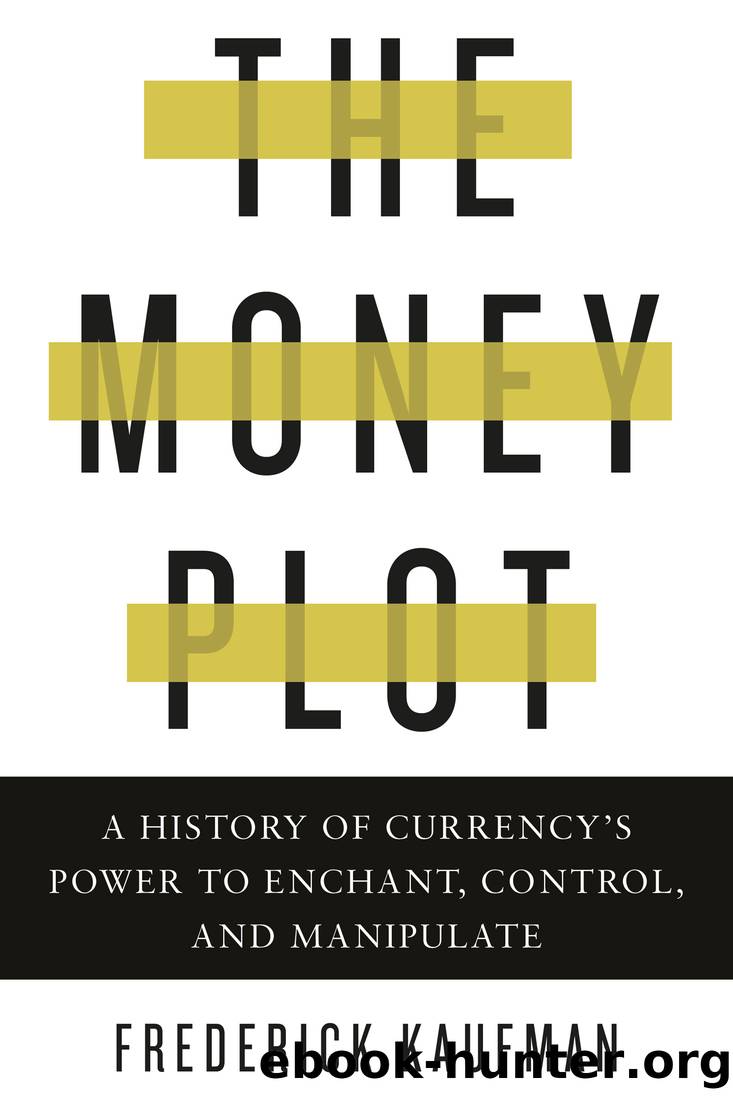The Money Plot by Frederick Kaufman

Author:Frederick Kaufman [Kaufman, Frederick]
Language: eng
Format: epub
Publisher: Other Press
Published: 2020-11-24T00:00:00+00:00
MONEY OBEYS THE RULES OF MATH, but math does not rule money. When it comes to creating and sustaining faith in a currency, the principles of narrative reign supreme. Like great characters, great currencies develop. The dollar faltered for more than one hundred years after its founding. It teetered into the twentieth century, then much like an adolescent on the verge of adulthood, matured and regressed in equal measure until, by the middle of the same century, it was ready to rescue the franc, the lire, the mark, the pound, and the yen.
Heroes often discard logic and reason in favor of fury and passion; likewise, the impulses that motivated the greatest character ever invented. Molded from farmland, flesh, fish, forests, sugar, and slaves, the dollar was and always would be synonymous with the American spirit. It epitomized the vision of Alexander Hamilton, Andrew Jackson, Woodrow Wilson, Franklin Delano Roosevelt, Richard Nixon, and Ronald Reagan. Nothing would surpass it.
Gold tried to keep the dollar in check. And there would be those who would remain loyal to yellow metal, those who could not see that it, too, was just another myth. They would have understood why Emperor Tiberius had tossed Sextus Marius off the Tarpeian Rock, that it was all about the measurable weight of an element.
But by the latter half of the nineteenth century, the outlines of a more nuanced philosophy of money had begun to emerge in Europe, personified in the figure of the haute financier, from whose like would descend the modern derivatives trader, financial engineer, leveraged buyout artist, and hedge fund billionaire. The financierâs assets were not hoarded in a hidden vault, nor locked in any single form. On the contrary, the financierâs money was fluid. When Otto von Bismarck and Napoleon III disagreed about the fate of Austria, the haute financiers suggested they might handle the problem by brokering the sale of Luxembourg to France. Which is to say that for these men, money was not only credit and debt, but art and politics. They would have understood the modern neoliberal dollarization of the world, in which the all-pervasive spirit of money inhabits every blade of grass, every ounce of mineral, gallon of water, and patented strand of genetically modified DNA. For the financier, that old fatal choice â gold or not gold â was a primitive relic. Money was the opposite of either/or.
America was the first sovereign state to make the haute financierâs worldview official. When Woodrow Wilson signed the Federal Reserve Act on Christmas Eve, 1913, the dollar became a Federal Reserve note â neither paper nor gold, yet both. For a long time afterward it would be impossible to say with precision what the dollar was and what it was not. Instead of either/or, the dollar had become both/and.
The first law of logic is the identity principle, which states that everything must equal itself: A equals A, a rose is a rose is a rose. From Aristotle to Zeno, philosophers had tested the limits of this proposition, all to no avail.
Download
This site does not store any files on its server. We only index and link to content provided by other sites. Please contact the content providers to delete copyright contents if any and email us, we'll remove relevant links or contents immediately.
Rich Dad Poor Dad by Robert T. Kiyosaki(6185)
Pioneering Portfolio Management by David F. Swensen(6083)
How To Win Friends and Influence People by Dale Carnegie(4341)
The Money Culture by Michael Lewis(3851)
The Dhandho Investor by Mohnish Pabrai(3564)
The Wisdom of Finance by Mihir Desai(3531)
Liar's Poker by Michael Lewis(3228)
The Intelligent Investor by Benjamin Graham Jason Zweig(2936)
The ONE Thing by Gary Keller(2922)
Mastering Bitcoin: Programming the Open Blockchain by Andreas M. Antonopoulos(2895)
Fooled by Randomness: The Hidden Role of Chance in Life and in the Markets by Nassim Nicholas Taleb(2867)
Rich Dad Poor Dad: What The Rich Teach Their Kids About Money - That The Poor And Middle Class Do Not! by Robert T. Kiyosaki(2836)
Investing For Dummies by Eric Tyson(2799)
How to Win Friends and Influence People by Dale Carnegie(2799)
How to Day Trade for a Living: Tools, Tactics, Money Management, Discipline and Trading Psychology by Andrew Aziz(2787)
Market Wizards by Jack D. Schwager(2545)
Zero Hour by Harry S. Dent Jr. & Andrew Pancholi(2537)
How to Pay Zero Taxes, 2018 by Jeff A. Schnepper(2503)
Rich Dad's Guide to Investing by Robert T. Kiyosaki(2412)
